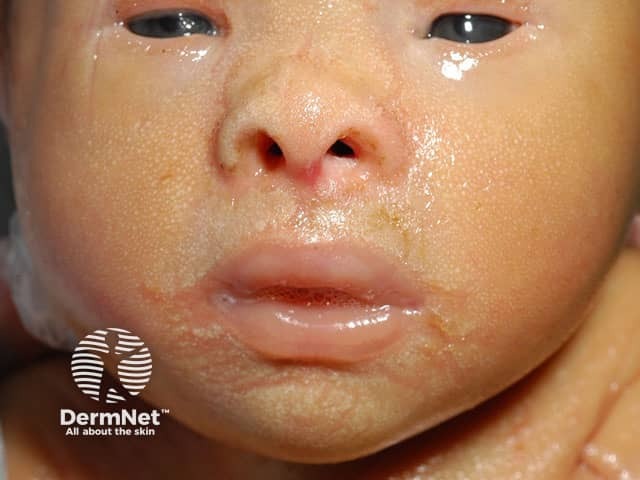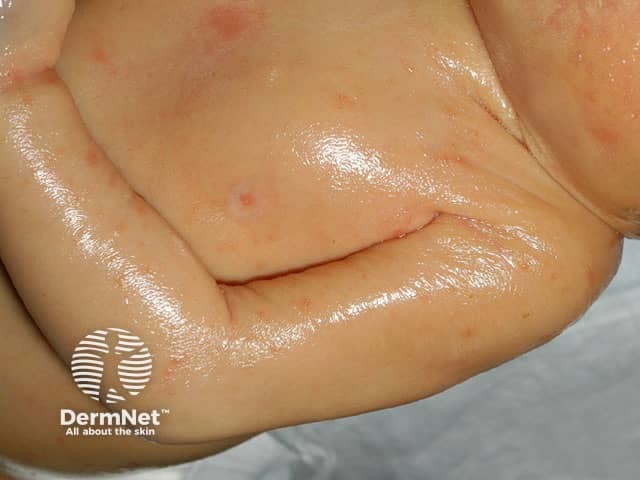Main menu
Common skin conditions

NEWS
Join DermNet PRO
Read more
Quick links
Collodion baby — extra information
Collodion baby
Author: Dr Sarah Hill, Dermatology Registrar, Dept of Dermatology Greenlane Hospital, Auckland, New Zealand, 2005.
What is a collodion baby?
Collodion baby is the name given to a baby who is born encased in a skin that resembles a yellow, tight and shiny film or dried collodion (sausage skin). These babies are often premature.
The collodion membrane undergoes desquamation or peeling, which is usually complete by 2 to 3 weeks of life. This reveals the underlying skin disorder.

Collodion baby

Collodion baby
What causes a collodion membrane?
The collodion membrane is due to abnormal desquamation. It is due to mutation of certain genes and is usually an autosomal recessive, congenital ichthyosis (scaly skin condition). However, 10% of collodion babies have normal underlying skin – a mild presentation known as ‘self-healing’ collodion baby.
The two most common underlying diseases are:
- Lamellar ichthyosis
- Non-bullous congenital erythroderma
Other rarer conditions include:
- Sjögren Larsson syndrome
- Gaucher Disease type 2
- Hay-Well syndrome
- Trichothiodystrophy
- Netherton syndrome
- Ectodermal dysplasia
- Neutral lipid storage disease.
What are the complications of the collodion membrane?
As the collodion membrane dries up it can crack leading to fissures. This affects the barrier function of the skin, leading to:
- Infection
- Overheating or cooling
- Dehydration.
Another concern is that the membrane acts like a thick film causing physical constraints of underlying tissues. This can create problems with:
- Suckling and nutrition
- Breathing
- Ectropion (lower eyelids turned outwards away from the eyeball)
- Constriction bands resulting in reduced blood supply and swelling of the limbs.
What is the management of a collodion baby?
The baby is usually transferred to a neonatal intensive care unit (NICU).
An incubator provides a humidified, neutral temperature environment. Other supportive treatments such as intravenous fluid and tube feeding are often necessary.
The aim is to keep the skin soft and attempt to reduce scaling. The collodion membrane should not be debrided (pulled off). Treatment may include:
- Regular emollients such as petrolatum to keep the skin moist
- Pain relief such as paracetamol
- Mild topical steroids to reduce secondary inflammation
- Artificial tears if there is severe ectropion (outward turning eyelid).
Management requires the expertise of a dermatologist and the paediatric team. Other specialists that may need to be involved include:
- Ophthalmologist
- Geneticist
- Physiotherapist.
The life expectancy and difficulties that the collodion baby faces depend upon the particular underlying condition.
References
- OMIM – Online Mendelian Inheritance in Man (search term Collodion baby)
On DermNet
Other websites
- Foundation for Ichthyosis and Related Skin Types
- Ichthyosis Information
- Lamellar ichthyosis — Medscape Reference
